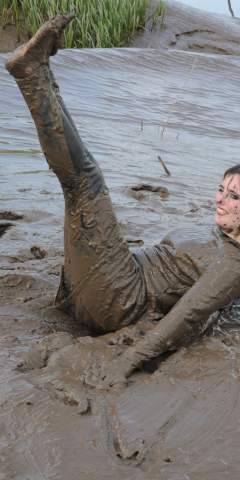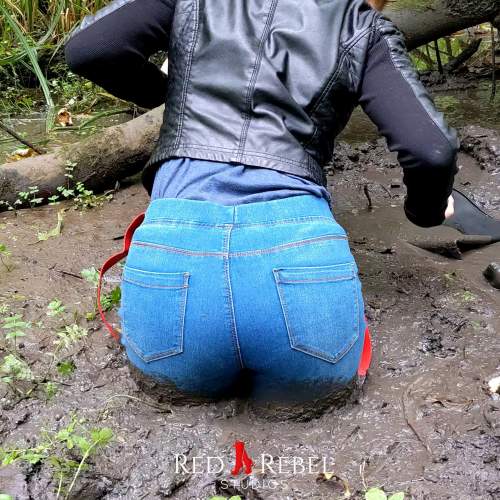|
|
|||
| forums: groups: | |||
|
"Self-discovered WAM science"
I only recently discovered the existence of communities and resources dedicated to WAM, and I was very happy to discover that this forum exists. However, for many years, I self-discovered ways of entertaining myself. I will share what I know. I am sure most of it is not new information, but you never know.
Of course I started with the obvious: food. Whipped cream seemed like the most natural choice. That was easy to clean too. Peanut butter was a LOT less easy to clean. Jelly worked well. The recent surge in popularity of Nutella (especially in the bear community for some reason) motivated me to try that. Warming it up created a great sensation, but it's probably the most annoying to wash off. I came to a realization that generally food items are not going to be cost effective or easy.
However, I learned that cornstarch and water forms a non-Newtonian fluid (*1) whose thickness can be controlled by the ratio. I used that a few times, but unless it is perfectly mixed it tends to bead up and be a giant pain to clean.
I knew there had to be a better solution. I did some cursory research and found out that you can create slime by mixing a solution of water, borax, and Elmer's white glue. The best analogy for why this works is that on a molecular level there is a "Velcro" effect between the glue and water-borax solution. This is like how one side of Velcro is rough and one side is fuzzy, but when you put them together they stay and those properties are no longer exposed.
The molecules of the materials together form a polymer that also acts as a non-Newtonian fluid, and the result is not sticky like the glue and also doesn't have the properties of the borax. This was perfect. It was extremely easy to wash away and actually left me cleaner than before I started due to a "silly putty" type of effect where the slime attracted and removed surface particles. The only downside to this material was the effort required to mix it. I still have some left-over Elmer's glue and borax to this day.
More recently I found but have not tried using a material called natrosol. I am currently in a situation where I have to save money, but I am wondering how cost-effective natrosol is and how easy it is to use to form slime.
What are your stories of self-discovery and/or opinions on good materials to use?
(*1) - A non-Newtonian fluid is a fluid whose viscosity varies depending on how much force is instantaneously being applied to it. Ketchup is the most readily available example of one whose viscosity decreases with applied force. Cornstarch and water is another one whose viscosity (conversely) rapidly increases with applied force. This is why you can run across a pool of it, but if you stop you will immediately sink.
Of course I started with the obvious: food. Whipped cream seemed like the most natural choice. That was easy to clean too. Peanut butter was a LOT less easy to clean. Jelly worked well. The recent surge in popularity of Nutella (especially in the bear community for some reason) motivated me to try that. Warming it up created a great sensation, but it's probably the most annoying to wash off. I came to a realization that generally food items are not going to be cost effective or easy.
However, I learned that cornstarch and water forms a non-Newtonian fluid (*1) whose thickness can be controlled by the ratio. I used that a few times, but unless it is perfectly mixed it tends to bead up and be a giant pain to clean.
I knew there had to be a better solution. I did some cursory research and found out that you can create slime by mixing a solution of water, borax, and Elmer's white glue. The best analogy for why this works is that on a molecular level there is a "Velcro" effect between the glue and water-borax solution. This is like how one side of Velcro is rough and one side is fuzzy, but when you put them together they stay and those properties are no longer exposed.
The molecules of the materials together form a polymer that also acts as a non-Newtonian fluid, and the result is not sticky like the glue and also doesn't have the properties of the borax. This was perfect. It was extremely easy to wash away and actually left me cleaner than before I started due to a "silly putty" type of effect where the slime attracted and removed surface particles. The only downside to this material was the effort required to mix it. I still have some left-over Elmer's glue and borax to this day.
More recently I found but have not tried using a material called natrosol. I am currently in a situation where I have to save money, but I am wondering how cost-effective natrosol is and how easy it is to use to form slime.
What are your stories of self-discovery and/or opinions on good materials to use?
(*1) - A non-Newtonian fluid is a fluid whose viscosity varies depending on how much force is instantaneously being applied to it. Ketchup is the most readily available example of one whose viscosity decreases with applied force. Cornstarch and water is another one whose viscosity (conversely) rapidly increases with applied force. This is why you can run across a pool of it, but if you stop you will immediately sink.
Always be excellent.
Welcome to the UMD!
Most of the "gunge" or slime you see in videos around here use some from of methylcellulose including hydroxyethylcellulose which is more commonly known as Natrosol.
Sites like messysupplies.com can ship you colored powders to mix, and even ready made gunge to your door.
Also, take a look around the site, as there are threads that have come up regarding slime recipes as well as our wiki. Cake batters and food coloring are also fairly common.
https://umd.net/wiki
Hopefully some other fellow WAMmers/sploshers will also chime in with some help and direction!
Most of the "gunge" or slime you see in videos around here use some from of methylcellulose including hydroxyethylcellulose which is more commonly known as Natrosol.
Sites like messysupplies.com can ship you colored powders to mix, and even ready made gunge to your door.
Also, take a look around the site, as there are threads that have come up regarding slime recipes as well as our wiki. Cake batters and food coloring are also fairly common.
https://umd.net/wiki
Hopefully some other fellow WAMmers/sploshers will also chime in with some help and direction!

He's more potato now than man. Twisted and evil.
This is less molecular chemistry and more food rheology, but, digression. Stirring cornstarch into water forms a suspension; the physical properties of its multiple phases are what contribute to its unique character. Starch can hold water, though, or be gelatinized; if the bonds between molecules in the polymer are broken down, terminal hydroxyl groups can engage more water, decreasing viscosity (generally, we say that starch absorbs water in this way). The energy available from hand-mixing at room temperature isn't enough to actually start this process, which is why just putting it into water forms the 'oobleck' suspension; usually, you have to mix some amount with water and heat it to get it going. You can make a pretty messy slime this way, actually; it's been described pretty regularly around the forum, though I haven't seen any videos off-hand that demonstrate results, and because of the energy capacity of water you have to wait a pretty long time for it to cool if you're going to use it for shenanigans. From a kitchen perspective, you're pretty much just making gravy without fat drippings and the like; if you follow a recipe for cornstarch gravy using water instead of a stock and omitting any of the seasonings and flavor components, this is basically exactly what you'll arrive at. This is a poorly-detailed explanation of the property of starches that we use to thicken sauces and the like. They're worth exploring for WAM if you have the patience, are okay with measurements and experiments, and/or are in a situation where you're interested in seeing results similar to what you'd get with one of the polymers described but aren't in a situation where you can have them delivered to you or don't want to buy without confidence.
If you need confidence, though: totally worth it.
Aside, the character of non-newtonian fluids to vary in viscosity can be further segregated based on how the viscosity varies with pressure applied over time. The suspension of cornstarch in water is "shear-thickening" (observed viscosity increases with shear stress) while the opposite case you've observed in ketchup is "shear-thinning". Natrosol (HEC) could be described as a more "lab-grade" thickening agent; it's similar to cornstarch, but made in such a way as to form a crystalline structure that is more accessible to water, allowing it to gelatinize with the energy available at room temperature and form thicker solutions with smaller amounts of solute. It forms gels in water that exhibit the same "shear-thinning" behavior: they are rich, thick, and gooey when poured out of vessels, but spread readily and with uncomplicated slickness when poured onto a body or material. Lotions, some coatings like paints, and even colloidal mixtures like whipped cream would demonstrate this behavior to some degree were you to make stress-strain curves for each of them.
If you need confidence, though: totally worth it.
Aside, the character of non-newtonian fluids to vary in viscosity can be further segregated based on how the viscosity varies with pressure applied over time. The suspension of cornstarch in water is "shear-thickening" (observed viscosity increases with shear stress) while the opposite case you've observed in ketchup is "shear-thinning". Natrosol (HEC) could be described as a more "lab-grade" thickening agent; it's similar to cornstarch, but made in such a way as to form a crystalline structure that is more accessible to water, allowing it to gelatinize with the energy available at room temperature and form thicker solutions with smaller amounts of solute. It forms gels in water that exhibit the same "shear-thinning" behavior: they are rich, thick, and gooey when poured out of vessels, but spread readily and with uncomplicated slickness when poured onto a body or material. Lotions, some coatings like paints, and even colloidal mixtures like whipped cream would demonstrate this behavior to some degree were you to make stress-strain curves for each of them.
A product intended for kids games is available here --> https://buckets-o-fun.com/product/sticky-yuck-slime/
The 'sticky yuck' is a long chain polymer that makes an insane amount of slime for the buck. You can even go to the website and request a free sample of their 4 kinds of yuck slime. But the 'sticky yuck' is the most concentrated of the lot, and it takes a small amount of powder mixed into quite a lot of water to create a very slippery liquid.
You can make it very liquidy - yet slippery, or go all the way to thick and stringy, just by varying the amount of water you mix in. It is water-soluable, so it is easy to rinse off. (but takes time to dissolve)
Best yet, it may be added to lots of other substances. For example, shaving foam can be turned into the consistency of marshmallow goo for a fraction of the cost of the real thing. Chocolate sauce can be made 'gooey' and more slippery just by adding a bit.
Please be aware though, that they are selling these slime products as entertainment for kids. The woman in charge probably has no idea that we even exist. So if you contact them, please act appropriately. They are great to deal with and their product is amazing.
The 'sticky yuck' is a long chain polymer that makes an insane amount of slime for the buck. You can even go to the website and request a free sample of their 4 kinds of yuck slime. But the 'sticky yuck' is the most concentrated of the lot, and it takes a small amount of powder mixed into quite a lot of water to create a very slippery liquid.
You can make it very liquidy - yet slippery, or go all the way to thick and stringy, just by varying the amount of water you mix in. It is water-soluable, so it is easy to rinse off. (but takes time to dissolve)
Best yet, it may be added to lots of other substances. For example, shaving foam can be turned into the consistency of marshmallow goo for a fraction of the cost of the real thing. Chocolate sauce can be made 'gooey' and more slippery just by adding a bit.
Please be aware though, that they are selling these slime products as entertainment for kids. The woman in charge probably has no idea that we even exist. So if you contact them, please act appropriately. They are great to deal with and their product is amazing.
I have had great success with a product called safety gel, its supplied in small sachets and two or three will thicken a 5 litre bucket of warm water for instant clothes filling fun etc, I got several box's cheapo from ebay etc. They are available in pack sizes of 100, also Thick and Easy if you can get the bulk 5 kg pack sizes on the cheap.
I have experimented with instant pudding. The first time I made it, it set more quickly than I expected (oops). Generally, if you add more water (the instructions call for milk) it won't set as quickly, and you can adjust the consistency to get what you want. I think the setting has to do with the interaction between the cornstarch, the other thickeners, and something in the milk - the notes claim that the pudding will not set if you use soy milk.
Also, it's pretty cheap (store brands are often on sale) and it washes off easily.
Also, it's pretty cheap (store brands are often on sale) and it washes off easily.
Sponsors
To avoid content being blocked due to your local laws, please verify your age ?
Sponsors

Design & Code ©1998-2025 Loverbuns, LLC 18 U.S.C. 2257 Record-Keeping Requirements Compliance Statement
Epoch Billing Support Log In





 Love you, too
Love you, too




























 VIP Coupons
VIP Coupons